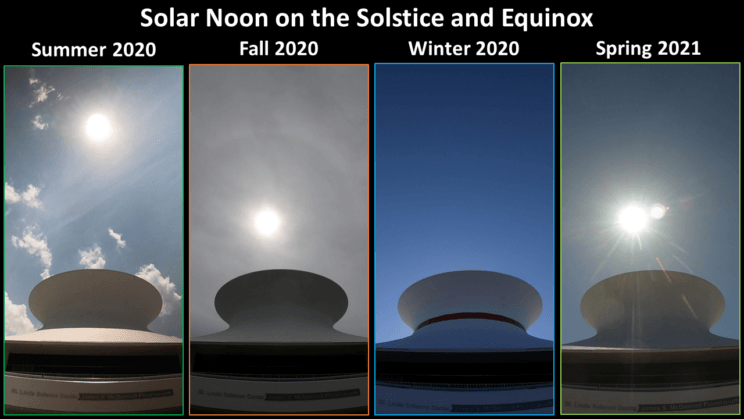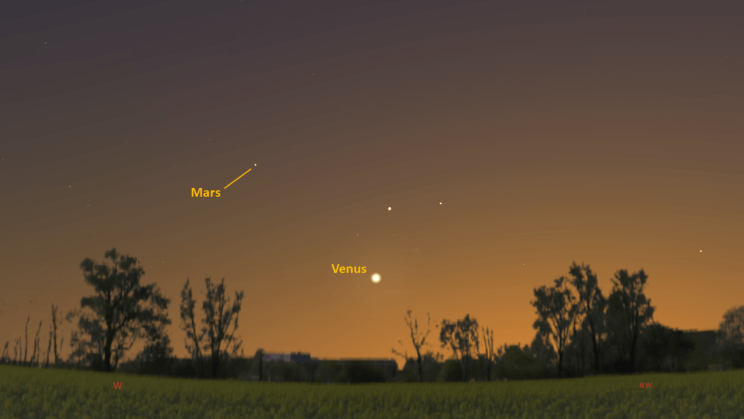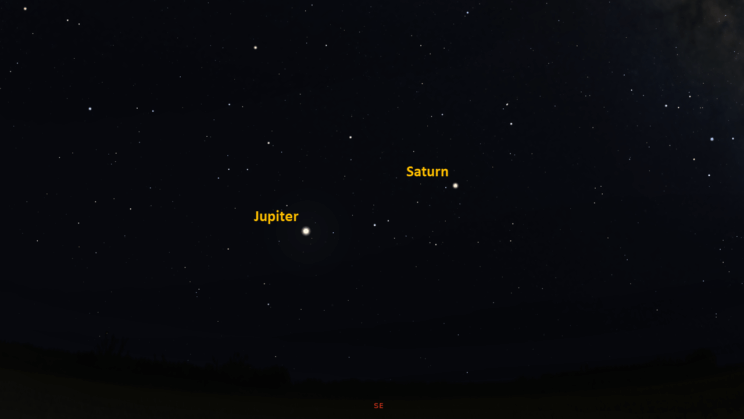This is the Saint Louis Science Center’s NIGHT SKY UPDATE for the week of Friday, June 18, 2021.
Information updated weekly or as needed.
Times given as local St. Louis time, which is Central Daylight Time (CDT). For definitions of terminology used in the night sky update, click the highlighted text. If relying on times posted in Universal Time (UT), St. Louis is -5 hours when CDT.
Public Telescope Viewings
With the changing recommendations from the CDC regarding COVID-19, conversations regarding the return of star parties at the Saint Louis Science Center have begun. We are close to bringing back our public telescope viewings, but a few details still need to be worked out. We will post future updates as we learn more about when we can bring back telescope viewings.
Observing Highlight of the Week

Solar Noon on the Summer and Winter Solstice and the Fall and Spring Equinox. Due to the Low Solar Altitude, The Sun Did Not Clear the James S. McDonnell Planetarium on the Winter Solstice.
Credit: Eric Gustafson
The summer solstice for the northern hemisphere occurs on June 21, 2021, at 10:23 p.m. The term “solstice” comes from the term solstitium, which roughly translates to “solar standstill.” Another way to think of this is the summer and winter solstice mark the extremes of the Sun’s annual behavior. The summer solstice is when the Sun is seen at its highest for the year, and the winter solstice is when it appears at its lowest. Our ancestors learned to track the annual behavior of the Sun which led to improved farming, navigation and time keeping. Observing the Sun’s annual behavior is a crucial part of what led to modern society.
Today, the summer solstice is what marks the start of summer. It is the longest day of the year, which leads to longer daylight hours and higher temperatures. Right now, we experience roughly 15 hours of daytime and four hours of twilight. This only leaves five hours of good darkness each day. The summer sky offers many treats for the backyard observer, but truly dark hours are hard to come by.
A common misconception about summertime is we are closer to the Sun; therefore, daily temperatures rise. This is incorrect. Summer for the northern hemisphere happens when Earth is near aphelion. This is the point in Earth’s orbit when Earth is at its greatest distance from the Sun. Seasonal changes in temperature and weather do not occur because of proximity to the Sun but rather due to Earth’s axial tilt. Our axial tilt of 23.4° causes the hemispheres to have varying exposures of direct sunlight. This seasonal variance is what drives our annual weather cycles.
Worldwide evidence for humans tracking the Sun’s annual behavior dates back thousands of years. Not far from St. Louis is the Illinois State Historic Site of Cahokia Mounds. Like many ancient cultures, the people that occupied this site were astronomers. Visiting Cahokia Mounds, you will find a recreation of a structure called Woodhenge. The reconstruction references a structure that existed about 1,000 years ago. It appears that Woodhenge served as a solar observatory allowing the people of Cahokia to track the Sun’s annual behavior. On Sunday, June 20, 2021, there will be an observance of the summer solstice held at Cahokia Mounds. For more information visit https://cahokiamounds.org/events/summer-solstice/
The Sun and Moon

The Moon as seen from the International Space Station, on July 31, 2011.
Credit: NASA
Sunrise is at 5:36 a.m. on Friday, June 11 and sunset is at 8:28 p.m. providing us with nearly 15 hours of daylight. Even after sunset, the light from the Sun will dimly illuminate our sky for about 2 hours. This period is called twilight, which ends around 10:26 p.m. this week. For those with a sundial, local noon occurs around 1:02 p.m. this week.
| Day | Sunrise | Sunset |
|---|---|---|
| 2021-06-18 | 5:36 a.m. | 8:28 p.m. |
| 2021-06-19 | 5:37 a.m. | 8:29 p.m. |
| 2021-06-20 | 5:37 a.m. | 8:29 p.m. |
| 2021-06-21 | 5:37 a.m. | 8:29 p.m. |
| 2021-06-22 | 5:37 a.m. | 8:29 p.m. |
| 2021-06-23 | 5:37 a.m. | 8:29 p.m. |
| 2021-06-24 | 5:38 a.m. | 8:30 p.m. |
| 2021-06-25 | 5:38 a.m. | 8:30 p.m. |
| 2021-06-26 | 5:40 a.m. | 8:30 p.m. |
Moon
Moonrise for Friday, June 18 occurs at 1:34 p.m. and moonset will occur at 2:00 a.m. on the following morning. On Friday, June 18 the Moon will exhibit a waxing gibbous phase with 56% of the lunar disk illuminated. Full moon for June occurs on June 24 at 1:40 p.m. Perigee for June 2021 occurs on June 23, during which the Moon will be 359,956 km from the Earth.
International Space Station (ISS) Observing

Visible passes of ISS from St. Louis for the week of June 18 occur during morning hours. The best pass this week occurs on the morning of June 25. Use the table below for information about this and other visible passes this week.
Catch ISS from St. Louis starting Friday, June 18
| Date | Starts | Max. altitude | Ends | |||||||
|---|---|---|---|---|---|---|---|---|---|---|
| Time | Alt. | Az. | Time | Alt. | Az. | Time | Alt. | Az. | ||
| 23 Jun | -1.1 | 04:56:33 | 10 | SSE | 04:58:19 | 14 | SE | 05:00:06 | 10 | E |
| 25 Jun | -2.9 | 04:56:44 | 10 | SSW | 04:59:56 | 42 | SE | 05:03:09 | 10 | ENE |
| 26 Jun | -2 | 04:10:56 | 17 | S | 04:12:35 | 24 | SE | 04:15:22 | 10 | ENE |
Magnitude (Mag): The Measure of brightness for a celestial object. The lower the value is, the brighter the object will be.
Altitude (Alt): The angle of a celestial object measured upwards from the observer’s horizon.
Azimuth (Az): The direction of a celestial object, measured clockwise from an observer’s location with north being 0°, east being 90°, south being 180° and west being 270°.
For information about ISS flyovers and other visible satellites, visit www.heavens-above.com
Detailed information regarding all unmanned exploration of our universe, missions past, present, and planned, can be found at Jet Propulsion Laboratories:
The Visible Planets

Looking West, at 9:00 pm, June 18, 2021
Credit: Stellarium, EG,

Looking Southeast, at 2:00 am, June 19, 2021
Credit: Stellarium, EG
This week, four naked eye planets are visible. Venus and Mars can be found in the west after sunset. Jupiter and Saturn can be found in the southeast before sunrise.
Venus
Venus is well into another evening apparition. By 8:58 p.m., Venus will be 10.6° above the west-northwest horizon. As 2021 continues, we will see Venus climb higher in the western sky after sunset until October 29 when it reaches maximum eastern elongation. After this date Venus will start to head back towards the Sun as it approaches inferior conjunction on January 8, 2022.
Mars
Currently Mars appears as a 1.8-magnitude object that will be visible high in the west about 40 minutes after sunset. Mars sets by 10:48 p.m. If you watch Mars and Venus as we head into July this year, you will see the two planets are getting closer in the sky. Mars and Venus are headed towards a conjunction on July 13, 2021. Conjunction happens before we seem them that day, so it is best to look for the pair on July 12 about 30 minutes after sunset. You will see the two planets less than 1° apart.
Jupiter
Jupiter is visible in the southeast before sunrise. Jupiter rises at 12:09 a.m. and will be easy to see in the southeast by 1:00 a.m.
Saturn
Saturn has returned to our morning sky. Saturn rises at 11:11 a.m. and will be easy to spot by 12:30 a.m. looking southeast.
James S. McDonnell Planetarium
Night Sky Update: June 18-June 26, 2021






